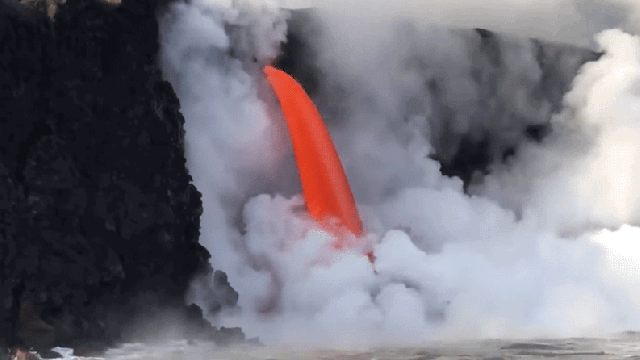Late last week, a cliff collapse extinguished the dramatic lava flow streaming out of Hawaii’s Kilauea volcano. We have some good news to report, however: It’s back! Some incredible new footage of the hellish gusher shows it’s alive and well.
Credit: Kalapana Cultural Tours
After the cliff collapsed on February 2, the satanic waterfall ground to a halt, but magma from the Kilauea volcano was still leaking into the ocean from below. On February 4, a local tour company visited the site thinking the lava flow had stopped. Much to the delight of everyone onboard, the molten gusher had returned in full force.
“Guests were surprised to see the lava fire hose lava still active,” noted Kalapana Cultural Tours on its Facebook page. Pictures and video taken by the tourist company showed the lava flow once again pouring from the cliffside.
On Sunday, the US Geological Survey’s Hawaiian Volcano Observatory updated its status report accordingly:
HVO scientists observed that a 30 m by 5 m (98 ft by 16 ft) portion of the block seaward of the hot crack REMAINED AFTER THE 12:55 p.m. collapse on Feb. 2. A significantly larger chunk fell into the ocean generating a noticeable, but not unusually large, wave propagating outward from the rockfall location. The dimensions of the collapsed block have not yet been documented.
The lava flow, named 61g, has captured the attention of geologists and much of the world since it first appeared late last month. HVO scientists say the unique gusher poses “no threat to nearby communities at this time”, but caution that visitors should keep their distance, both in the area where the lava meets the sea and on the land nearby.
“Venturing too close to an ocean entry on land or the ocean exposes you to flying debris created by the explosive interaction between lava and water,” warn the scientists. “Also, the new land created is unstable because it is built on unconsolidated lava fragments and sand. This loose material can easily be eroded away by surf, causing the new land to become unsupported and slide into the sea.”
In addition, the HVO warns that the interaction of lava with the ocean creates “a corrosive seawater plume laden with hydrochloric acid” and “fine volcanic particles that can irritate the skin, eyes, and lungs”.
It’s a beautiful spectacle, but it’s as dangerous as it looks.
